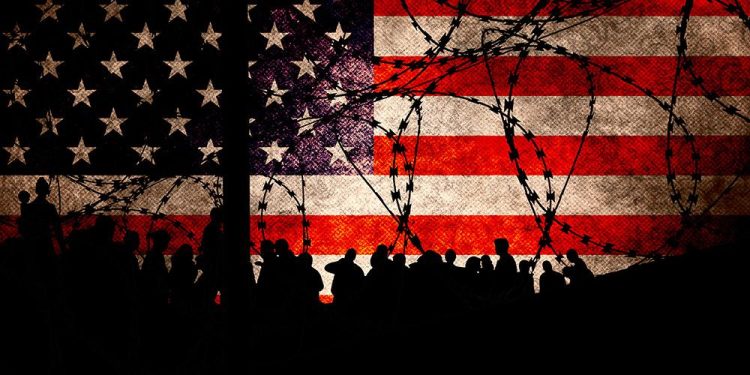(Natural News)—Just in time for Election Day, another three caravans full of migrants are marching north towards Mexico’s border with the United States for a planned invasion.
Real America’s Voice correspondent Oscar Ramirez reported live from America’s southern border with Mexico about what this all means for Americans in the coming days.
“The disaster continues,” Ramirez said in an interview. “This is all responsibility under the Biden administration, the Kamala Harris and Biden administration.”
“For everybody to know, we have documented 11 caravans. Out of the 11 caravans that Real America’s Voice has documented, 10 of them have happened under the Biden-Harris administration. They just released three caravans in the last past weeks, three of them under the new president of Mexico, Claudia Sheinbaum, the first president.”
Ramirez says the most recent migrant caravan to enter the U.S. illegally under Sheinbaum is the largest one, boasting 2,500 people.
“A lot of people do not know what Kamala Harris just did,” Ramirez further said, noting that the powers that be (TPTB) are unwilling to wait for the CBP (Customs and Border Protection) One app.”
“Just a couple of months ago, she created the CBP One app, application, this application for to bypass immigration, into Tapachulatapas. The CBP One app was not working in Tapachulatapas, but she knew that this massive influx was going to come because they know that they are losing this election and the illegal migrants are going to try to make a run for it, so she created this deterrent for them to not look bad, but it just backfired on them and it has been continuous with caravans after caravans after caravans.”
(Related: Did you know that both the U.S. and the UN are funding the illegal migrant invasion of America using cash in envelopes?)
Illegal migrants tired of waiting to enter U.S.
Ramirez says that the migrant caravans hail from all over the world, including South America, Africa and the Middle East. The majority of them, he says, are military-aged males, meaning this is an invasion by foreign enemies.
When asked what these migrant caravans plan to do once they reach the U.S.-Mexico border, Ramirez revealed that after speaking with many of the migrants personally, they said they are tired of waiting to enter the U.S. legally and plan to just bum-rush the country.
“We’re just going to go to the borders to see an open border gap, pay a cartel member or pay a smuggler, try to deliver ourselves to the Border Patrol, and enter illicitly into the United States of America – that is the new process,” Ramirez explained.
“This normalization of entering illegally through every border has a collateral damage, and it is all under the responsibility of the Biden-Harris administration. This is the collateral damage that it has created alongside the continent.”
“Also, Mexico is complicit because it is allowing these caravans to continue. And the new president … she is allowing these caravans to continue right now before the 5th of November. So they know that there are changes that are going to happen drastically in the United States of America, and this is the last chance they have, possibly.”
The latest Border Report shows that the spots where the most illegal migrants try to enter the U.S. illegally include El Paso, Tex., Tucson, Ariz., and San Diego, Calif.
In the month of September alone, CBP apprehended 13,309 migrants in San Diego; 12,507 migrants in El Paso; and 11,055 migrants in Tucson. The vast majority of them are single adults, especially in El Paso where only 1,327 of the detainees came with one or more additional family members.
The latest news about America’s illegal alien problem can be found at InvasionUSA.news.
Sources for this article include:






The way to handle the out-of-control immigration debacle is simple. 1. Close the borders, 2. Setup a system to have a mandatory registration for all non-U.S. citizens within a 6-month time period. ID cards would be issued, which lists the name, address, birth date, date entered into the U.S., status, picture, social services to be provided, fingerprint, expiration date, and signature. Since immigration is a Federal responsibility, the registration/ID issued could be set up at Post Offices. Currently, the U.S. Government has no clue as to how many illegals are in the country and has been estimated at 11 million for decades. The registration system would provide a more accurate number of how many “guests” are in the U.S. and where they are located. Anyone caught using a fake ID or that of another person would be charged and immediately deport. I know some will claim that forcing a mandatory ID would resemble the Germans in WWII. However, this is incorrect because the illegals have the choice of registering or they can leave to return to there country of origin. I know many want all the illegals immediately deported but realistically that is impossible. Deportation needs to be made in an orderly fashion.
“Three More Invader Caravans Heading Towards U.S.-Mexico Border”
—THEY WANT TO GET TO THE US BEFORE NOVEMBER 5 TO VOTE FOR HARRIS-WALZ !!!!
Biden-Harris INSPIRE lawless immigration through their policy decisions. PERIOD. FULL STOP.
now can we start shooting to defend our country from foreign invasion?? These are foreign enemies who should be repelled with force.